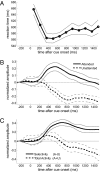Behavioral performance follows the time course of neural facilitation and suppression during cued shifts of feature-selective attention
- PMID: 20643918
- PMCID: PMC2922290
- DOI: 10.1073/pnas.1002436107
Behavioral performance follows the time course of neural facilitation and suppression during cued shifts of feature-selective attention
Abstract
A central question in the field of attention is whether visual processing is a strictly limited resource, which must be allocated by selective attention. If this were the case, attentional enhancement of one stimulus should invariably lead to suppression of unattended distracter stimuli. Here we examine voluntary cued shifts of feature-selective attention to either one of two superimposed red or blue random dot kinematograms (RDKs) to test whether such a reciprocal relationship between enhancement of an attended and suppression of an unattended stimulus can be observed. The steady-state visual evoked potential (SSVEP), an oscillatory brain response elicited by the flickering RDKs, was measured in human EEG. Supporting limited resources, we observed both an enhancement of the attended and a suppression of the unattended RDK, but this observed reciprocity did not occur concurrently: enhancement of the attended RDK started at 220 ms after cue onset and preceded suppression of the unattended RDK by about 130 ms. Furthermore, we found that behavior was significantly correlated with the SSVEP time course of a measure of selectivity (attended minus unattended) but not with a measure of total activity (attended plus unattended). The significant deviations from a temporally synchronized reciprocity between enhancement and suppression suggest that the enhancement of the attended stimulus may cause the suppression of the unattended stimulus in the present experiment.
Conflict of interest statement
The authors declare no conflict of interest.
Figures


References
-
- Nobre AC. The attentive homunculus: Now you see it, now you don't. Neurosci Biobehav Rev. 2001;25:477–496. - PubMed
-
- Nobre AC, Sebestyen GN, Miniussi C. The dynamics of shifting visuospatial attention revealed by event-related potentials. Neuropsychologia. 2000;38:964–974. - PubMed
-
- Slagter HA, Kok A, Mol N, Kenemans JL. Spatio-temporal dynamics of top-down control: Directing attention to location and/or color as revealed by ERPs and source modeling. Brain Res Cogn Brain Res. 2005;22:333–348. - PubMed
-
- Yamaguchi S, Tsuchiya H, Kobayashi S. Electroencephalographic activity associated with shifts of visuospatial attention. Brain. 1994;117:553–562. - PubMed
Publication types
MeSH terms
LinkOut - more resources
Full Text Sources

